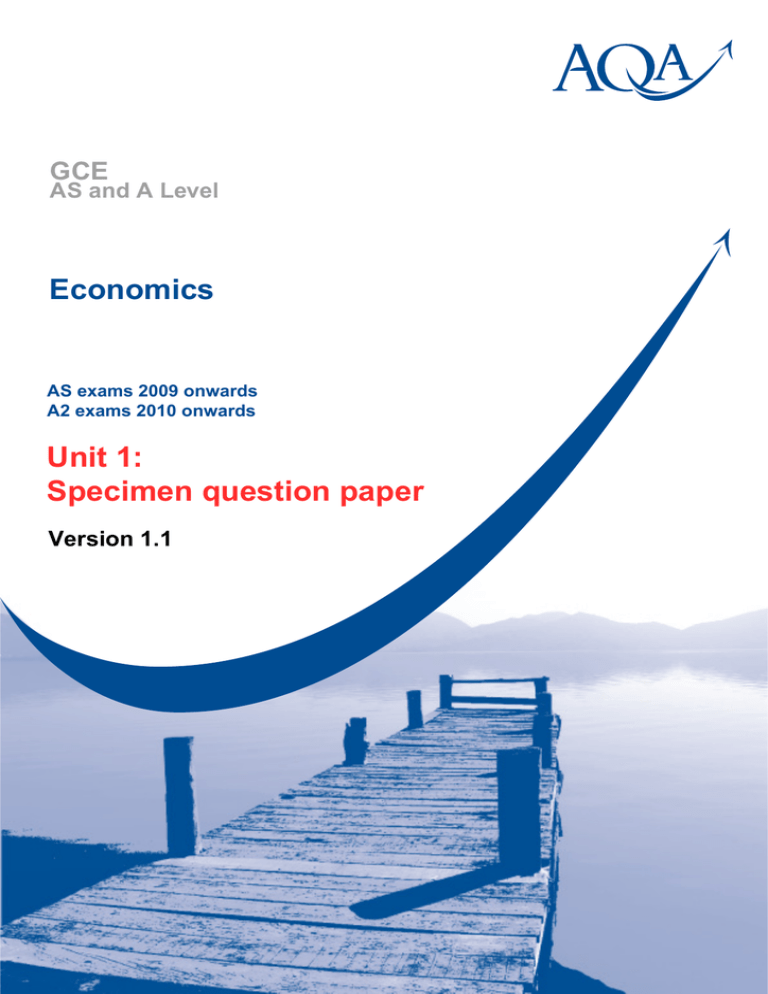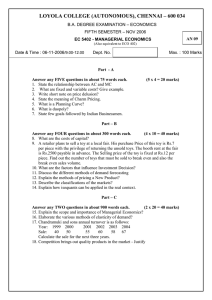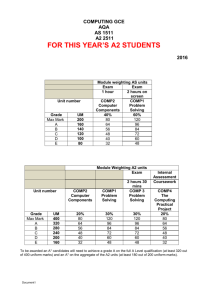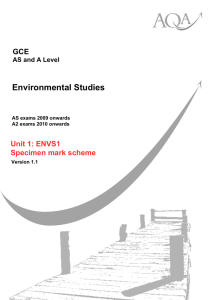
GCE
AS and A Level
Economics
AS exams 2009 onwards
A2 exams 2010 onwards
Unit 1:
Specimen question paper
Version 1.1
This page has been left blank
AQA GCE Economics Unit 1 – Specimen Paper for 2009-10: Version 1.1, approved (July 2007)
General Certificate of Education
Specimen Paper for examinations in 2009 onwards
Advanced Subsidiary Examination
ECONOMICS
Unit 1 Markets and Market Failure
ECON1
For this paper you must have:
• an objective test answer sheet
• a black ball-point pen
• an 8-page answer book.
You may use a calculator.
Time allowed: 1 hour 15 minutes
Instructions
• In Section A, answer all questions on your objective test answer sheet.
• In Section B, answer EITHER Question 26 OR Question 27 in your answer book.
• Do all rough work in your answer book, not on your objective test answer sheet.
Section A
• Use a black ball-point pen. Do not use pencil.
• For each question in Section A there are four alternative responses. When you have selected the
response which you think is the best answer to a question, mark this response on your objective test
answer sheet. If you wish to change your answer to a question, follow the instructions on your
objective test answer sheet.
•
•
Section B
Use black ink or black ball-point pen. Pencil should only be used for drawing.
Write the information required on the front of your answer book. The Examining Body for this paper
is AQA. The Paper Reference is ECON1.
Information
• The maximum mark for this paper is 75 marks.
• There are 25 marks for Section A and 50 marks for Section B.
• In Section A, each question carries 1 mark. No deductions will be made for wrong answers.
• In Section B, the marks for questions are shown in brackets.
• You will be marked on your ability to use good English, to organise information clearly and to use
specialist vocabulary where appropriate.
Advice
• You are advised to spend no more than 25 minutes on Section A and at least 50 minutes on
Section B.
ECON1
2
AQA GCE Economics Unit 1 – Specimen Paper for 2009-10: Version 1.1, approved (July 2007)
____________________________________________________________________________________
SECTION A : OBJECTIVE TEST
Answer all questions in Section A.
Each question carries 1 mark. No deductions will be made for wrong answers.
You are advised to spend no more than 25 minutes on Section A.
Each question is followed by four responses, A, B, C and D.
For each question select the best response and mark its letter on the objective test answer sheet provided.
1
2
Which one of the following is a normative statement?
A
Economists classify economic resources as land, labour, capital and enterprise.
B
The environment is an example of a scarce resource.
C
An unequal distribution of resources is unfair.
D
Economies have limited means to satisfy unlimited wants.
The diagram below shows an economy’s production possibility frontier, KJ.
The movement along the production possibility frontier from point X to point Y means that
A
the economy has become more productively efficient.
B
more of the economy’s resources are being utilised.
C
the economy benefits from economies of scale.
D
there is an increase in the opportunity cost of consumption goods.
3
AQA GCE Economics Unit 1 – Specimen Paper for 2009-10: Version 1.1, approved (July 2007)
___________________________________________________________________________________
3
4
5
6
Which one of the following would be included in the economist’s definition of physical capital?
A
A professional soccer player
B
North Sea Oil
C
The Amazonian rainforest
D
An engineer’s electric drill
The income elasticity of demand for an inferior good is
A
negative.
B
inelastic.
C
unitary.
D
zero.
A shift to the right of the demand curve for a product could be caused by a
A
fall in the price of that product.
B
fall in the price of close substitutes.
C
rise in income.
D
rise in production costs.
The European Union has recommended switching from subsidies for intensive farming to
environmentally-friendly farming methods and protection of the landscape. From this
recommendation it may be concluded that
A
the social benefits of food subsidies exceed the social costs.
B
intensive farming methods result in positive externalities.
C
the net external benefits of subsidies for care of the environment exceed those from
subsidising intensive food production.
D
reduced government financial support for farming will lead to lower food prices and an
increase in external benefits.
Turn over ►
4
AQA GCE Economics Unit 1 – Specimen Paper for 2009-10: Version 1.1, approved (July 2007)
____________________________________________________________________________________
7
The diagram below shows two supply curves for orange juice.
The shift from S1 to S2 could have been caused by an increase in
8
9
A
the cost of oranges.
B
incomes of consumers.
C
the level of tax on orange juice.
D
government subsidies on orange juice.
When the price mechanism is used to allocate resources, prices
A
must rise.
B
are usually regulated by central government.
C
are solely determined by production costs.
D
signal to producers the strength of demand and supply.
A manufacturer reduces the price of its washing machines by 5% and, as a result, the volume of
sales of washing machines rises by 4%. Therefore, the price elasticity of demand for the good is
A
-1.25
B
-1.0
C
-0.8
D
+1.25
5
AQA GCE Economics Unit 1 – Specimen Paper for 2009-10: Version 1.1, approved (July 2007)
___________________________________________________________________________________
10
The diagram below shows the demand and supply curves of a consumer good where P1 is the initial
equilibrium price.
The increase in price from P1 to P2 may be caused by
11
A
an increase in the price of substitutes and a fall in raw material costs.
B
a fall in incomes and a rise in interest rates.
C
an increase in the wages paid to all workers.
D
an increase in income tax and Value Added Tax (VAT).
The table below shows the demand and supply schedules for eggs.
Price per box
Quantity of boxes
demanded per week
Quantity of boxes
supplied per week
£1.50
180
240
£1.40
200
200
£1.30
220
160
£1.20
240
120
As a result of a fall in production costs, supply rises by 60 boxes at all prices. What would be the
new equilibrium price?
A
£1.50
B
£1.40
C
£1.30
D
£1.20
Turn over ►
6
AQA GCE Economics Unit 1 – Specimen Paper for 2009-10: Version 1.1, approved (July 2007)
____________________________________________________________________________________
12
13
14
15
16
A firm is productively efficient when it
A
benefits from economies of scale.
B
operates at the minimum point of its average cost curve.
C
operates profitably.
D
is the only firm in the industry.
A firm expands and as it does so it employs larger machines that enable it to produce more output
for a given amount of inputs. This is an example of
A
an internal economy of scale.
B
an external economy of scale.
C
a financial economy of scale.
D
a diseconomy of scale.
If a monopoly exists in a particular industry, any benefit for consumers is most likely to arise from
A
economies of scale.
B
barriers to entry.
C
diseconomies of scale.
D
excess profits.
A positive externality exists when
A
the social cost of consumption exceeds the private cost of consumption.
B
the private benefit of production exceeds the social benefit of production.
C
the consumption of the product provides benefits to third parties.
D
the production of the product imposes costs on third parties.
When applied to a public good, ‘non-rival’ means that
A
there is a single monopoly supplier of the good.
B
the resources used in its production could not have been used to produce other goods.
C
if the good is provided for one person it must be provided for others.
D
consumption of the good by one person does not reduce the amount of the good available to
others.
7
AQA GCE Economics Unit 1 – Specimen Paper for 2009-10: Version 1.1, approved (July 2007)
___________________________________________________________________________________
17
18
19
Monopolies lead to market failure because they
A
use barriers to entry to restrict competition.
B
earn some profit.
C
are more innovative than competitive firms.
D
rarely benefit from economies of scale.
The government of a country which is a major tourist destination has proposed a tax of up to £5.00
per tourist for every night spent in hotel accommodation. The government would be most likely to
justify this in terms of
A
the external benefits of tourism.
B
the external costs of tourism.
C
the private costs of tourism.
D
the private benefits of tourism.
The diagram below shows a firm’s average cost (AC) curve.
At the minimum point of the firm’s AC curve, point X above, the firm
A
must be making maximum profits.
B
is productively efficient.
C
will have market power.
D
is misallocating resources.
Turn over ►
8
AQA GCE Economics Unit 1 – Specimen Paper for 2009-10: Version 1.1, approved (July 2007)
_________________________________________________________________________________________________________________
20
21
22
23
24
Which one of the following is a likely consequence of the abuse of market power by a monopolist?
A
A misallocation of resources
B
Positive externalities in consumption
C
Increased competition between firms
D
Over-production of merit goods
Government intervention in the market through the payment of subsidies to firms can be justified if
these firms
A
are subject to diseconomies of scale.
B
have highly inelastic supply curves.
C
create negative externalities.
D
supply merit goods.
A policy of increasing subsidies for inner-city public transport is most likely to cause a fall in
A
negative externalities.
B
government borrowing.
C
the demand for bus and train drivers.
D
the level of local taxation.
Which one of the following is an example of government intervention to correct market failure?
A
An increase in the rate of Value Added Tax (VAT) on all goods and services
B
The taxation of negative externalities
C
An increase in teachers’ salaries
D
The taxation of public goods
Price elasticity of supply measures the responsiveness of the quantity supplied to a change in
A
demand.
B
price.
C
cost.
D
production.
9
AQA GCE Economics Unit 1 – Specimen Paper for 2009-10: Version 1.1, approved (July 2007)
___________________________________________________________________________________
25
The diagram below shows the marginal private and social benefit (MPB and MSB) curves and the
marginal private and social cost (MPC and MSC) curves for a consumer good that creates a negative
externality in production.
In the absence of intervention by the government the private market equilibrium is at point J with an
industry output of Q1. To achieve a more efficient level of output for the good the government could
A
introduce a subsidy of EG per unit produced.
B
set a minimum price of OE per unit sold.
C
set a maximum price of OG per unit sold.
D
impose a tax of EG on each unit of the good produced.
QUESTION 25 IS THE LAST
QUESTION IN SECTION A
On your answer sheet
ignore rows 26 to 50
Turn over for Section B
Turn over ►
10
AQA GCE Economics Unit 1 – Specimen Paper for 2009-10: Version 1.1, approved (July 2007)
____________________________________________________________________________________
SECTION B: DATA RESPONSE
Answer EITHER Question 26 OR Question 27.
You are advised to spend at least 50 minutes on Section B.
Total for this question: 50 marks
26 PRICES AND MARKET FAILURE
Study Extracts A and B, and then answer all parts of Question 26 which follows.
Extract A: Housing facts and figures, 2006
Average UK house price
Average household savings
Average mortgage required by first-time buyers
Average wage for men
Typical mortgage allowed by lenders on the
above wage (3.5 times earnings)
London planning guidance definition of
‘affordable housing’
Typical mortgage allowed by lenders for
‘affordable’ housing as defined above (normally
3.5 times earnings)
Actual typical prices of ‘affordable’ houses in
London in November 2006
Proportion of London workers earning £30 000
or less per year
Number of extra households estimated for the
next 20 years
Region where most of these houses will be
needed
£200 000
£10 000
£190 000
£25 000 per year
£87 500
Houses available to workers
earning £16 400 to £49 000
per year
£57 400 - £171 500
£127 000 - £375 000
50%
5 million
London and the South-East
11
AQA GCE Economics Unit 1 – Specimen Paper for 2009-10: Version 1.1, approved (July 2007)
___________________________________________________________________________________
Extract B: ‘Affordable’ housing
London borough councils now accept that many homes officially designated as ‘affordable’ are
1
actually too expensive for anyone earning less than £40 000 per year, This certainly excludes most
nurses, teachers, police officers, fire-fighters, bus drivers, and any other ‘key workers’ you care to
name.
Affordable housing schemes include:
•
•
•
5
‘social housing’ not provided by a ‘market’ but by a landlord, usually a housing association;
‘intermediate’ housing, often on a ‘shared ownership’ basis, where families on low incomes
pay partly by mortgage, partly by rent, plus any service charges;
‘market housing’ built by low-cost techniques, such as pre-fabrication (this is much less
common).
10
As we move from ‘social’ through ‘intermediate’ to the ‘market’, it appears to become more
difficult to solve the problem of affordability. The Canadian economist John Kenneth Galbraith
once said, “No market system in the world has ever succeeded in housing all its people”.
According to the United Nations nearly a billion people live in slums (one in six of the world’s
population, which could rise to one in three over the next 30 years unless action is taken). Poor
housing conditions and homelessness create massive negative externalities, whereas good
housing can be regarded as a merit good with strong positive externalities.
If only a specially-targeted portion of the housing market is ‘affordable’, this implies that most
houses on the market are ‘unaffordable’ – a strange idea indeed. Rising house prices are usually
treated by the media as ‘good news’. A recent newspaper headline actually said: “No danger of
homes for all just yet”.
One of the country’s largest home loans providers now says it will offer mortgages of up to five
times joint salaries. The monthly repayment would be roughly half a couple’s take-home pay.
Other lenders have hinted at mortgages lasting 60 years instead of the usual 25. Some borrowers
are only paying the interest on their mortgages, and not repaying the capital loan. Are these
sensible ways of helping people such as first-time buyers? Or are people becoming addicted to
debt?
15
20
25
Question 26
26 (a) Using Extract A, identify three reasons why house prices in the UK tend to be ‘unaffordable’.
(5 marks)
26 (b) Define income elasticity of demand and explain why a knowledge of the income elasticity of
demand for housing would be useful to an economist wishing to study the housing market.
(8 marks)
26 (c) Using a supply and demand diagram to help you, analyse the possible effects of a government
decision to impose a maximum price on new houses in London and the South-East. (12 marks)
26 (d) Explain why poor housing conditions and homelessness can lead to negative externalities
(Extract B, lines 15-16) and evaluate the role that governments could play in avoiding market
failure in the housing market.
(25 marks)
Turn over ►
12
AQA GCE Economics Unit 1 – Specimen Paper for 2009-10: Version 1.1, approved (July 2007)
____________________________________________________________________________________
Do not answer Question 27 if you have answered Question 26.
Total for this question: 50 marks
27
COMPETITION AND MARKET POWER
Study Extracts C, D and E, and then answer all parts of Question 27 which follows.
Extract C: Worldwide sales of toys and games, US $ billion
US $ billion
Extract D: Prices and competition in toyland
In the 1990s the market power of big discount superstore chains such as Toys ‘R Us and
Wal-Mart drove many smaller speciality retailers out of business. Manufacturers felt that the
concentration of power in the hands of a few retailers was devaluing brands that they had spent
years building up and reducing their ability to innovate. Retailers have arguably been in a
stronger position than either manufacturers or consumers to benefit from the lower manufacturing
costs of massively switching production to China.
1
5
Fewer, larger toy shops mean less shelf space. Retailers wield more power over which products
are sold and the prices for which they sell.
One of the challenges for all toy shops is the seasonality of toy purchases. Every Christmas there
is a ‘must-have’ toy, the item that children desperately want. Every year, there are shortages and
stocks sell out before parents have managed to get out their credit cards. It can be difficult to
predict which toy this will be.
10
In 2006, the ‘must-have’ was the Nintendo Wii games console. This was launched in Europe on
8 December with a manufacturer’s recommended retail price of £169. All of the 50 000 machines
shipped to the UK were snapped up in 12 hours. However, during the week before Christmas it
15
was possible to buy one for about £330 on eBay.
Out of total retail spending in the UK of £33 billion in December 2006, £7 billion was spent on-line.
Virtual shopping through sites like eBay is likely to be a huge influence on the market for toys in
the next decade.
13
AQA GCE Economics Unit 1 – Specimen Paper for 2009-10: Version 1.1, approved (July 2007)
____________________________________________________________________________________
Extract E: Selling toys: a new ball game
Total global internet trading was estimated in 2006 to be growing at 40 per cent per annum.
1
Sites like eBay have reduced barriers to entry into the market for all sorts of budding entrepreneurs,
including toy retailers. EBay now has a membership of 181 million people in 33 countries. As well as
these individual buyers and sellers, worldwide there are 383 000 eBay ‘shops’. People considering
opening a commercial small enterprise have found that auctioning their items on eBay is much easier
than operating a bricks-and-mortar business. They can enjoy marketing economies previously only
available to large firms: instead of hoping that 20 or 30 people might come through their door each
day, they have instant access to thousands of potential customers around the world.
5
In a typical day in December 2006, eBay listings for ‘toys and games’, ‘video games’ and ‘books,
comics and magazines’ showed a total of over 400 000 individual items on sale.
Question 27
27 (a) Using Extract C, compare the sales of traditional toys and video games in 2003 with estimated
sales in 2008.
(5 marks)
27 (b) State and explain two ways in which eBay might help reduce barriers to entry for specialist toy
retailers (Extract E, lines 2-3).
(8 marks)
27 (c) With the help of a supply and demand diagram, analyse the reasons why shortages can occur in
the market for toys and games as mentioned in Extract D.
(12 marks)
27 (c) Do you agree that monopoly power among toy retailers will continue to grow and that further
growth of monopoly power would harm both consumers and toy manufacturers? Justify your
answer, using the data and your economic knowledge.
(25 marks)
END OF QUESTIONS
ACKNOWLEDGEMENT OF COPYRIGHT-HOLDERS AND PUBLISHERS
Permissions to reproduce all copyright material has been applied for. In some cases, efforts to contact copyright-holders have been unsuccessful and AQA
will be happy to rectify any omissions of acknowledgements in future papers if notified.
Copyright © 2007 AQA and its licensors. All rights reserved.
10




